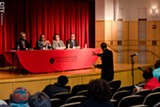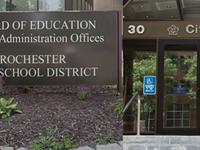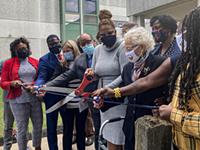[
{
"name": "500x250 Ad",
"insertPoint": "5",
"component": "15667920",
"parentWrapperClass": "",
"requiredCountToDisplay": "1"
}
]
The Rochester City School District has myriad problems and failures. At its root, generational poverty is a key cause for its systemic failure. However, we cannot believe that if this issue is addressed more coherently, the structure will respond successfully. The reality is that it can't.
The continuous failure of the district and the death grip of poverty require us to ask basic "what if" questions. What if we started over? What if we could build something from the ground up? Would we build what we have now?
What if school was thought of as a concept and not a place? For example, the senior year in high school could be redesigned to provide experiences related to community service, independent study using technology, and service to younger students as "senior mentors." The stranglehold of schooling occurring only in school sites needs to be reconsidered at all levels.
What if success was built upon a new "3 R's"? Bill Gates has described three basic building blocks for successful schools: rigor ("making sure all students are given a challenging curriculum that prepares them for college or work"); relevance ("making sure kids have courses and projects that clearly relate to their lives and their goals"), and relationships ("making sure kids have a number of adults who know them, look out for them, and push them to achieve").
What if the large RCSD was divided into two smaller districts, one east of the Genesee River, the other to the west of it? Each district would have its own school board, superintendent, budget, and union contracts. The large, centralized approach has proved unmanageable and consistently unable to respond to the unique needs of city neighborhoods. Affiliate the new west district with BOCES 2 and the western region suburban districts. Affiliate the east district with BOCES 1 and the eastern region suburban districts.
The current "go it alone" philosophy disinvites many others who could and should engage in the education of Rochester's students. The two new RCSD districts would enable competition and end the current historical bickering as new boards, administrations, and union leadership emerge. The model doesn't guarantee success, but the current bureaucracy and inability to cooperate must be addressed in a manner that turns the page and forges new alliances and opportunities that have heretofore been closed.
What if the two new regional districts worked with non-profit agencies to provide additional collaboration and support for their students? One outstanding example of this is the Communities in Schools effort that has documented success when working with at risk students in high-need areas across the country (www.communitiesinschools.org).
What if a different staffing model was used? The 20th-century model for instructional delivery is expensive. It fails to assertively use technology, differentiated staffing, and alternative settings for learning. Teaching Assistants can be deployed under the supervision of certified classroom teachers. Using a TA model could be a catalyst for employment within the community from which the students come.
What if K-12 schooling was 12 months in duration? We cannot sacrifice time when the evidence indicates that children lose ground over a two-month hiatus from school. An alternative staffing model could open the door to this possibility.
What if students age 2 to 8 were enrolled in an early-learning setting where literacy and social interactions became the foundational goals? Research proves that language and concept development are wonderfully formative at this early age. Students in poverty cannot be shortchanged by lack of proper developmental experiences and exposure to a wide breadth of literacy which, if not forged early, are a serious detriment to subsequent learning. TA's could be used in this model.
In addition to the "what ifs," the district must overcome the lack of sound, long-term, strategic planning. Leadership turnover and the contentious dynamics related to board relations, unions, the mayor's office, and the larger community have been underlying excuses for not addressing this urgent need.
The mission of the district should be a straightforward one: "To create the right conditions for learning for every student." We can debate (and should) what "right" means. However, it should be based upon the Gates Foundation's new 3 R's. In addition, the Distinguished Educator's Report is an excellent starting point for prioritizing strategic initiatives.
However, all of this is premised on improving what is. The most important aspect of a strategic plan is not to see it as an improvement effort. It is an opportunity to reinvent, to deal honestly and openly with "What if's."
It is time to stop tinkering at the margins.
One likely response to what I have suggested is that it is unaffordable. The financial state of the Rochester City School District is another major area that needs a complete overhaul. The size of the current organization does not provide economies of scale. In fact, the reverse is happening.
Shrinking the size to two separate regional districts would enable a better grasp on resources and their subsequent deployment. Using a new staffing model with a significant increase in TA's for direct instruction versus exclusively using certified teachers can provide a new way to expand the school year and day without requiring a dramatic increase in funding. While there would be fewer teachers, their roles and leadership responsibilities would be elevated.
Finally, it is evident that the RCSD's response to the Distinguished Educator's Report prescribes a huge amount of busy work. Sadly, too many of the tasks outlined will not fundamentally change the depth and breadth of student learning. If there were an opportunity to do things over, it is unlikely the system currently in place would be the right answer. If this is a basic truth, why are those involved about to devote a vast amount of time, talent, and resources to continue it?
A 21st-century education cannot be built on a 20th-century foundation of failure and neglect. It is time for a systemic call to action, where re-invention and re-visioning are the expected outcomes. It is time to draw upon the vast resources of the larger community to build an education system that truly serves students with high needs in areas where poverty cruelly reigns.
Rick Stein was a public-schools educator for 38 years, six of them as superintendent of the Gates Chili Central School District.









